A Survey of Ultra-Low-Power Amplifiers for Internet of Things Nodes
Abstract
:1. Introduction
2. Subthreshold Approach
3. Body-Driven Approach
4. Body-Biased Approach
5. Inverter-Based Approach
6. Digital Approach
7. Comparison and Discussion
8. Conclusions
Author Contributions
Funding
Conflicts of Interest
Abbreviations
| BB | Bulk-Biased |
| BD | Bulk-Driven |
| CAD | Computer-Aided Design |
| CMOS | Complementary Metal–Oxide–Semiconductor |
| CMRR | Common-Mode Rejection Ratio |
| DIGOTA | Digital OTA |
| GBW | Gain–Bandwidth product |
| IoT | Internet of Things |
| MOS | Metal–Oxide–Semiconductor |
| OTA | Operational Transconductance Amplifier |
| PM | Phase Margin |
| PSRR | Power Supply Rejection Ratio |
| PVT | Process, Supply, and Temperature |
| SR | Slew Rate |
References
- Number of Internet of Things (IoT) Connected Devices Worldwide from 2019 to 2021, with Forecasts from 2022 to 2030. Available online: https://www.statista.com/statistics/1183457/iot-connected-devices-worldwide/ (accessed on 6 September 2023).
- Alioto, M. (Ed.) Enabling the Internet of Things: From Integrated Circuits to Integrated Systems; Springer International Publishing: Berlin/Heidelberg, Germany, 2017; ISBN 978-3-319-51480-2. [Google Scholar]
- Jang, T.; Kim, G.; Kempke, B.; Henry, M.B.; Chiotellis, N.; Pfeiffer, C.; Kim, D.; Kim, Y.; Foo, Z.; Kim, H.; et al. Circuit and System Designs of Ultra-Low Power Sensor Nodes with Illustration in a Miniaturized GNSS Logger for Position Tracking: Part I—Analog Circuit Techniques. IEEE Trans. Circuits Syst. Regul. Pap. 2017, 64, 2237–2249. [Google Scholar] [CrossRef]
- Sansen, W. 1.3 Analog CMOS from 5 Micrometer to 5 Nanometer. In Proceedings of the 2015 IEEE International Solid-State Circuits Conference—(ISSCC) Digest of Technical Papers, San Francisco, CA, USA, 22–26 February 2015; pp. 1–6. [Google Scholar]
- Vittoz, E.; Fellrath, J. CMOS Analog Integrated Circuits Based on Weak Inversion Operations. IEEE J. Solid-State Circuits 1977, 12, 224–231. [Google Scholar] [CrossRef]
- Hollis, T.M.; Comer, D.J.; Comer, D.T. Optimization of MOS Amplifier Performance through Channel Length and Inversion Level Selection. IEEE Trans. Circuits Syst. II Express Briefs 2005, 52, 545–549. [Google Scholar] [CrossRef]
- Valero Bernal, M.R.; Celma, S.; Medrano, N.; Calvo, B. An Ultralow-Power Low-Voltage Class-AB Fully Differential OpAmp for Long-Life Autonomous Portable Equipment. IEEE Trans. Circuits Syst. II Express Briefs 2012, 59, 643–647. [Google Scholar] [CrossRef]
- Chatterjee, S.; Tsividis, Y.; Kinget, P. 0.5-V Analog Circuit Techniques and Their Application in OTA and Filter Design. IEEE J. Solid-State Circuits 2005, 40, 2373–2387. [Google Scholar] [CrossRef]
- Magnelli, L.; Amoroso, F.A.; Crupi, F.; Cappuccino, G.; Iannaccone, G. Design of a 75-nW, 0.5-V Subthreshold Complementary Metal–Oxide–Semiconductor Operational Amplifier. Int. J. Circuit Theory Appl. 2014, 42, 967–977. [Google Scholar] [CrossRef]
- Qin, Z.; Tanaka, A.; Takaya, N.; Yoshizawa, H. 0.5-V 70-nW Rail-to-Rail Operational Amplifier Using a Cross-Coupled Output Stage. IEEE Trans. Circuits Syst. II Express Briefs 2016, 63, 1009–1013. [Google Scholar] [CrossRef]
- Grasso, A.D.; Marano, D.; Palumbo, G.; Pennisi, S. Design Methodology of Subthreshold Three-Stage CMOS OTAs Suitable for Ultra-Low-Power Low-Area and High Driving Capability. IEEE Trans. Circuits Syst. Regul. Pap. 2015, 62, 1453–1462. [Google Scholar] [CrossRef]
- Blalock, B.J.; Allen, P.E.; Rincon-Mora, G. Designing 1-V Op Amps Using Standard Digital CMOS Technology. IEEE Trans. Circuits Syst. II Analog Digit. Signal Process. 1998, 45, 769–780. [Google Scholar] [CrossRef]
- Bialko, M.; Guzinski, A.; Allen, P.E.; Blalock, B.J.; Rincon-Mora, G. Comments on “Designing 1-V Op-Amps Using Standard Digital CMOS Technology” [and Reply]. IEEE Trans. Circuits Syst. II Analog Digit. Signal Process. 1999, 46, 1448. [Google Scholar] [CrossRef]
- Lehmann, T.; Cassia, M. 1-V Power Supply CMOS Cascode Amplifier. IEEE J. Solid-State Circuits 2001, 36, 1082–1086. [Google Scholar] [CrossRef]
- Stockstad, T.; Yoshizawa, H. A 0.9-V 0.5-Um Rail-to-Rail CMOS Operational Amplifier. IEEE J. Solid-State Circuits 2002, 37, 286–292. [Google Scholar] [CrossRef]
- Carrillo, J.M.; Duque-Carrillo, J.F.; Torelli, G.; Ausin, J.L. Constant-g/Sub m/Constant-Slew-Rate High-Bandwidth Low-Voltage Rail-to-Rail CMOS Input Stage for VLSI Cell Libraries. IEEE J. Solid-State Circuits 2003, 38, 1364–1372. [Google Scholar] [CrossRef]
- Carrillo, J.M.; Torelli, G.; Perez-Aloe Valverde, R.; Duque-Carrillo, J.F. 1-V Rail-to-Rail CMOS OpAmp With Improved Bulk-Driven Input Stage. IEEE J. Solid-State Circuits 2007, 42, 508–517. [Google Scholar] [CrossRef]
- Ferreira, L.H.C.; Pimenta, T.C.; Moreno, R.L. An Ultra-Low-Voltage Ultra-Low-Power CMOS Miller OTA with Rail-to-Rail Input/Output Swing. IEEE Trans. Circuits Syst. II Express Briefs 2007, 54, 843–847. [Google Scholar] [CrossRef]
- Monsurrò, P.; Pennisi, S.; Scotti, G.; Trifiletti, A. 0.9-V CMOS Cascode Amplifier with Body-Driven Gain Boosting. Int. J. Circuit Theory Appl. 2009, 37, 193–202. [Google Scholar] [CrossRef]
- Raikos, G.; Vlassis, S. Low-Voltage Bulk-Driven Input Stage with Improved Transconductance. Int. J. Circuit Theory Appl. 2011, 39, 327–339. [Google Scholar] [CrossRef]
- Zuo, L.; Islam, S.K. Low-Voltage Bulk-Driven Operational Amplifier with Improved Transconductance. IEEE Trans. Circuits Syst. Regul. Pap. 2013, 60, 2084–2091. [Google Scholar] [CrossRef]
- Ferreira, L.H.C.; Sonkusale, S.R. A 60-dB Gain OTA Operating at 0.25-V Power Supply in 130-Nm Digital CMOS Process. IEEE Trans. Circuits Syst. Regul. Pap. 2014, 61, 1609–1617. [Google Scholar] [CrossRef]
- Abdelfattah, O.; Roberts, G.W.; Shih, I.; Shih, Y.C. An Ultra-Low-Voltage CMOS Process-Insensitive Self-Biased OTA With Rail-to-Rail Input Range. IEEE Trans. Circuits Syst. Regul. Pap. 2015, 62, 2380–2390. [Google Scholar] [CrossRef]
- Cabrera-Bernal, E.; Pennisi, S.; Grasso, A.D.; Torralba, A.; Carvajal, R.G. 0.7-V Three-Stage Class-AB CMOS Operational Transconductance Amplifier. IEEE Trans. Circuits Syst. Regul. Pap. 2016, 63, 1807–1815. [Google Scholar] [CrossRef]
- Vlassis, S.; Kulej, T.; Khateb, F.; Souliotis, G. 0.5 V Bulk-Driven Ring Amplifier Based on Master–Slave Technique. Analog Integr. Circuits Signal Process. 2017, 90, 189–197. [Google Scholar] [CrossRef]
- Kulej, T.; Khateb, F. Design and Implementation of Sub 0.5-V OTAs in 0.18-Μm CMOS. Int. J. Circuit Theory Appl. 2018, 46, 1129–1143. [Google Scholar] [CrossRef]
- Woo, K.-C.; Yang, B.-D. A 0.25-V Rail-to-Rail Three-Stage OTA With an Enhanced DC Gain. IEEE Trans. Circuits Syst. II Express Briefs 2020, 67, 1179–1183. [Google Scholar] [CrossRef]
- Kulej, T.; Khateb, F. A 0.3-V 98-dB Rail-to-Rail OTA in 0.18 μm CMOS. IEEE Access 2020, 8, 27459–27467. [Google Scholar] [CrossRef]
- Ballo, A.; Grasso, A.D.; Pennisi, S. 0.4-V, 81.3-nA Bulk-Driven Single-Stage CMOS OTA with Enhanced Transconductance. Electronics 2022, 11, 2704. [Google Scholar] [CrossRef]
- Ballo, A.; Grasso, A.D.; Pennisi, S.; Susinni, G. A 0.3-V 8.5-μ A Bulk-Driven OTA. IEEE Trans. Very Large Scale Integr. VLSI Syst. 2023, 31, 1444–1448. [Google Scholar] [CrossRef]
- Grasso, A.D.; Monsurrò, P.; Pennisi, S.; Scotti, G.; Trifiletti, A. Analysis and Implementation of a Minimum-Supply Body-Biased CMOS Differential Amplifier Cell. IEEE Trans. Very Large Scale Integr. VLSI Syst. 2009, 17, 172–180. [Google Scholar] [CrossRef]
- Centurelli, F.; Monsurro, P.; Pennisi, S.; Scotti, G.; Trifiletti, A. Design Solutions for Sample-and-Hold Circuits in CMOS Nanometer Technologies. IEEE Trans. Circuits Syst. II Express Briefs 2009, 56, 459–463. [Google Scholar] [CrossRef]
- Grasso, A.D.; Pennisi, S.; Scotti, G.; Trifiletti, A. 0.9-V Class-AB Miller OTA in 0.35-μm CMOS With Threshold-Lowered Non-Tailed Differential Pair. IEEE Trans. Circuits Syst. Regul. Pap. 2017, 64, 1740–1747. [Google Scholar] [CrossRef]
- Nauta, B. A CMOS Transconductance-C Filter Technique for Very High Frequencies. IEEE J. Solid-State Circuits 1992, 27, 142–153. [Google Scholar] [CrossRef]
- Andreani, P.; Mattisson, S. On the Use of Nauta’s Transconductor in Low-Frequency CMOS g/Sub m/-C Bandpass Filters. IEEE J. Solid-State Circuits 2002, 37, 114–124. [Google Scholar] [CrossRef]
- Figueiredo, M.; Santos-Tavares, R.; Santin, E.; Ferreira, J.; Evans, G.; Goes, J. A Two-Stage Fully Differential Inverter-Based Self-Biased CMOS Amplifier with High Efficiency. IEEE Trans. Circuits Syst. Regul. Pap. 2011, 58, 1591–1603. [Google Scholar] [CrossRef]
- Shrimali, H.; Chatterjee, S. 11 GHz UGBW Op-Amp with Feed-Forward Compensation Technique. In Proceedings of the 2011 IEEE International Symposium of Circuits and Systems (ISCAS), Rio de Janeiro, Brazil, 15–18 May 2011; pp. 17–20. [Google Scholar]
- Kaliyath, Y.; Laxminidhi, T. A 1.8 V 11.02 μW Single-Ended Inverter-Based OTA with 113.62 dB Gain. In Proceedings of the 2016 IEEE Distributed Computing, VLSI, Electrical Circuits and Robotics (DISCOVER), Mangalore, India, 13–14 August 2016; pp. 237–241. [Google Scholar]
- Rodovalho, L.H.; Aiello, O.; Rodrigues, C.R. Ultra-Low-Voltage Inverter-Based Operational Transconductance Amplifiers with Voltage Gain Enhancement by Improved Composite Transistors. Electronics 2020, 9, 1410. [Google Scholar] [CrossRef]
- Bae, W. CMOS Inverter as Analog Circuit: An Overview. J. Low Power Electron. Appl. 2019, 9, 26. [Google Scholar] [CrossRef]
- Manfredini, G.; Catania, A.; Benvenuti, L.; Cicalini, M.; Piotto, M.; Bruschi, P. Ultra-Low-Voltage Inverter-Based Amplifier with Novel Common-Mode Stabilization Loop. Electronics 2020, 9, 1019. [Google Scholar] [CrossRef]
- Sala, R.D.; Centurelli, F.; Scotti, G. A Novel Differential to Single-Ended Converter for Ultra-Low-Voltage Inverter-Based OTAs. IEEE Access 2022, 10, 98179–98190. [Google Scholar] [CrossRef]
- Centurelli, F.; Giustolisi, G.; Pennisi, S.; Scotti, G. A Biasing Approach to Design Ultra-Low-Power Standard-Cell-Based Analog Building Blocks for Nanometer SoCs. IEEE Access 2022, 10, 25892–25900. [Google Scholar] [CrossRef]
- Crovetti, P.S. A Digital-Based Analog Differential Circuit. IEEE Trans. Circuits Syst. Regul. Pap. 2013, 60, 3107–3116. [Google Scholar] [CrossRef]
- Toledo, P.; Crovetti, P.; Aiello, O.; Alioto, M. Fully Digital Rail-to-Rail OTA With Sub-1000-Μm2 Area, 250-mV Minimum Supply, and nW Power at 150-pF Load in 180 Nm. IEEE Solid-State Circuits Lett. 2020, 3, 474–477. [Google Scholar] [CrossRef]
- Toledo, P.; Crovetti, P.; Aiello, O.; Alioto, M. Design of Digital OTAs With Operation Down to 0.3 V and nW Power for Direct Harvesting. IEEE Trans. Circuits Syst. Regul. Pap. 2021, 68, 3693–3706. [Google Scholar] [CrossRef]
- Toledo, P.; Crovetti, P.; Klimach, H.; Bampi, S.; Aiello, O.; Alioto, M. A 300mV-Supply, Sub-nW-Power Digital-Based Operational Transconductance Amplifier. IEEE Trans. Circuits Syst. II Express Briefs 2021, 68, 3073–3077. [Google Scholar] [CrossRef]
- Toledo, P.; Rubino, R.; Musolino, F.; Crovetti, P. Re-Thinking Analog Integrated Circuits in Digital Terms: A New Design Concept for the IoT Era. IEEE Trans. Circuits Syst. II Express Briefs 2021, 68, 816–822. [Google Scholar] [CrossRef]
- Palumbo, G.; Scotti, G. A Novel Standard-Cell-Based Implementation of the Digital OTA Suitable for Automatic Place and Route. J. Low Power Electron. Appl. 2021, 11, 42. [Google Scholar] [CrossRef]
- Toledo, P.; Crovetti, P.S.; Klimach, H.D.; Musolino, F.; Bampi, S. Low-Voltage, Low-Area, nW-Power CMOS Digital-Based Biosignal Amplifier. IEEE Access 2022, 10, 44106–44115. [Google Scholar] [CrossRef]
- Privitera, M.; Crovetti, P.S.; Grasso, A.D. A Novel Digital OTA Topology with 66-dB DC Gain and 12.3-kHz Bandwidth. IEEE Trans. Circuits Syst. II Express Briefs 2023. early access. [Google Scholar] [CrossRef]
- Ramirez-Angulo, J.; Carvajal, R.G.; Tombs, J.; Torralba, A. Low-Voltage CMOS Op-Amp with Rail-to-Rail Input and Output Signal Swing for Continuous-Time Signal Processing Using Multiple-Input Floating-Gate Transistors. IEEE Trans. Circuits Syst. II Analog Digit. Signal Process. 2001, 48, 111–116. [Google Scholar] [CrossRef]
- Ramirez-Angulo, J.; Lopez-Martin, A.J.; Carvajal, R.G.; Chavero, F.M. Very Low-Voltage Analog Signal Processing Based on Quasi-Floating Gate Transistors. IEEE J. Solid-State Circuits 2004, 39, 434–442. [Google Scholar] [CrossRef]
- Rajput, K.K.; Saini, A.K.; Bose, S.C. DC Offset Modeling and Noise Minimization for Differential Amplifier in Subthreshold Operation. In Proceedings of the 2010 IEEE Computer Society Annual Symposium on VLSI, Lixouri, Greece, 5–7 July 2010; pp. 247–252. [Google Scholar]
- Di Cataldo, G.; Grasso, A.D.; Pennisi, S.; Scotti, G.; Trifiletti, A. CMOS Non-Tailed Differential Pair: CMOS Non-Tailed Differential Pair. Int. J. Circuit Theory Appl. 2015, 44, 1468–1477. [Google Scholar] [CrossRef]
- Khateb, F. Bulk-Driven Floating-Gate and Bulk-Driven Quasi-Floating-Gate Techniques for Low-Voltage Low-Power Analog Circuits Design. AEU-Int. J. Electron. Commun. 2014, 68, 64–72. [Google Scholar] [CrossRef]
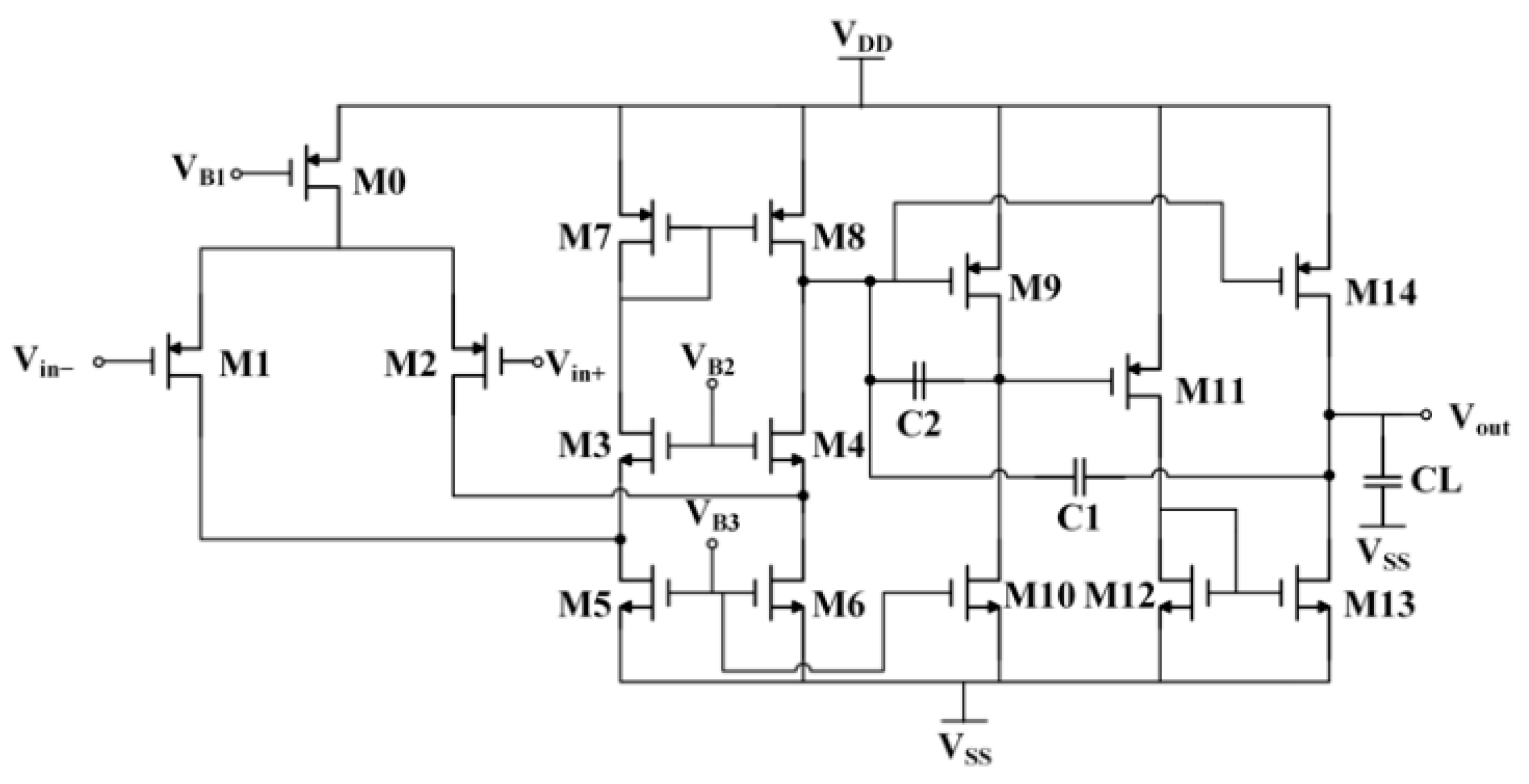

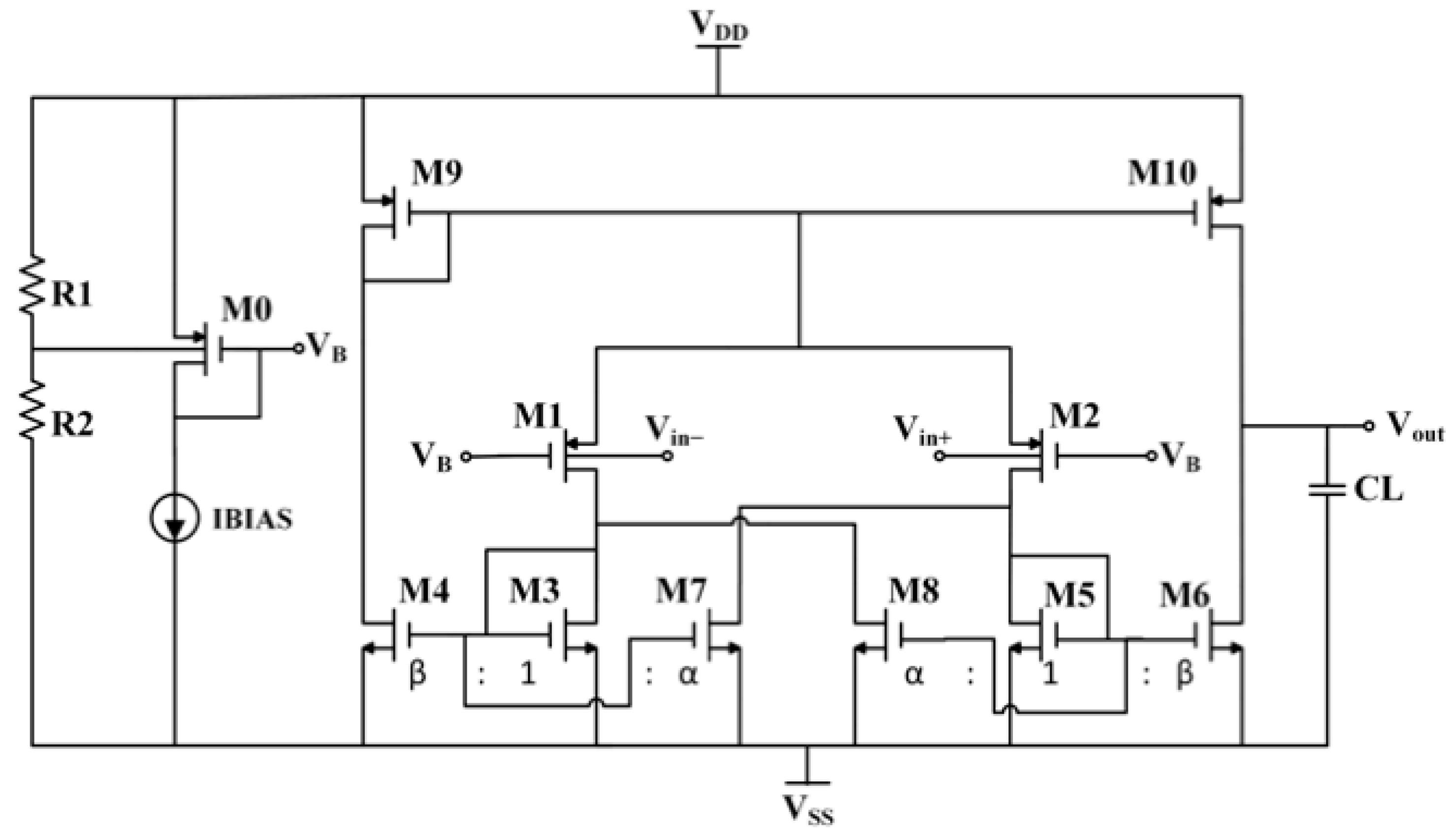
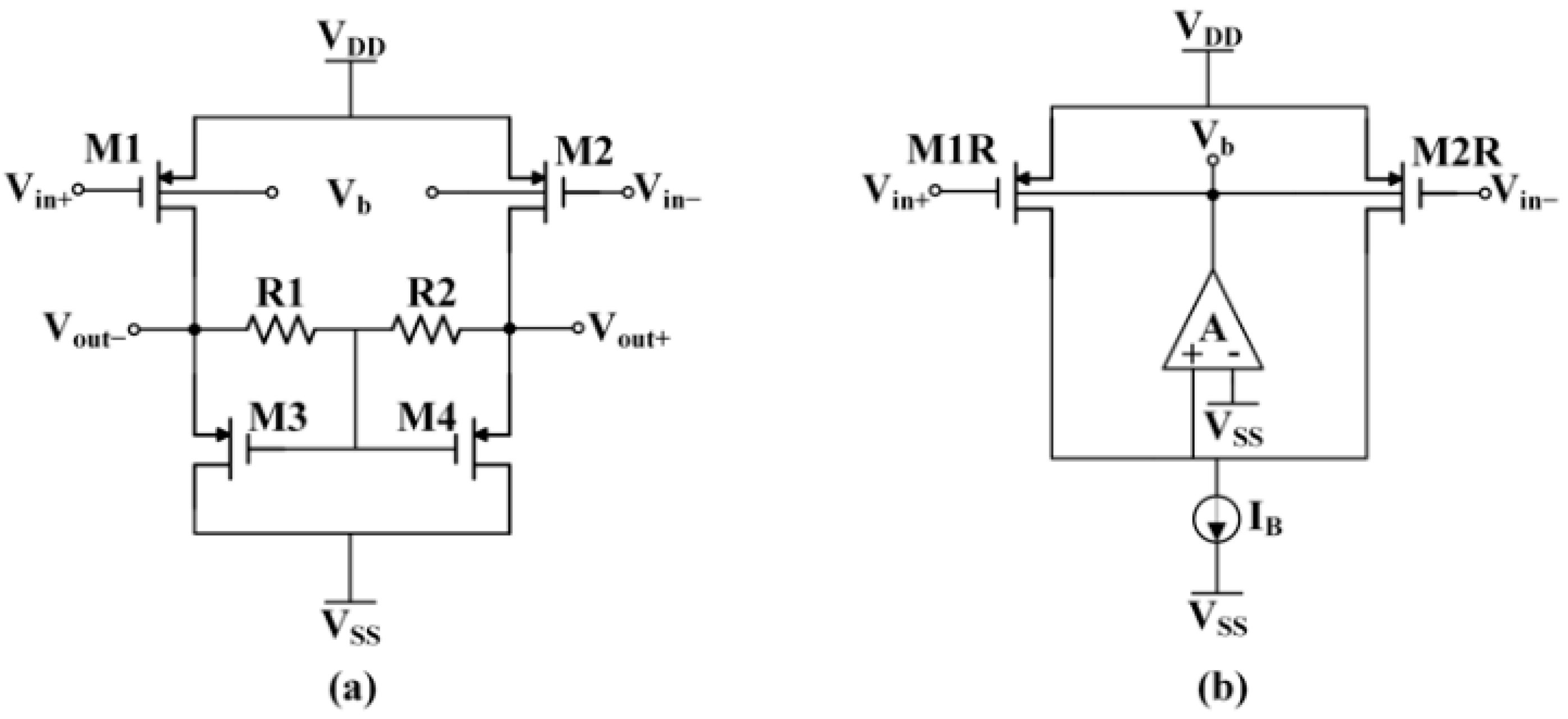
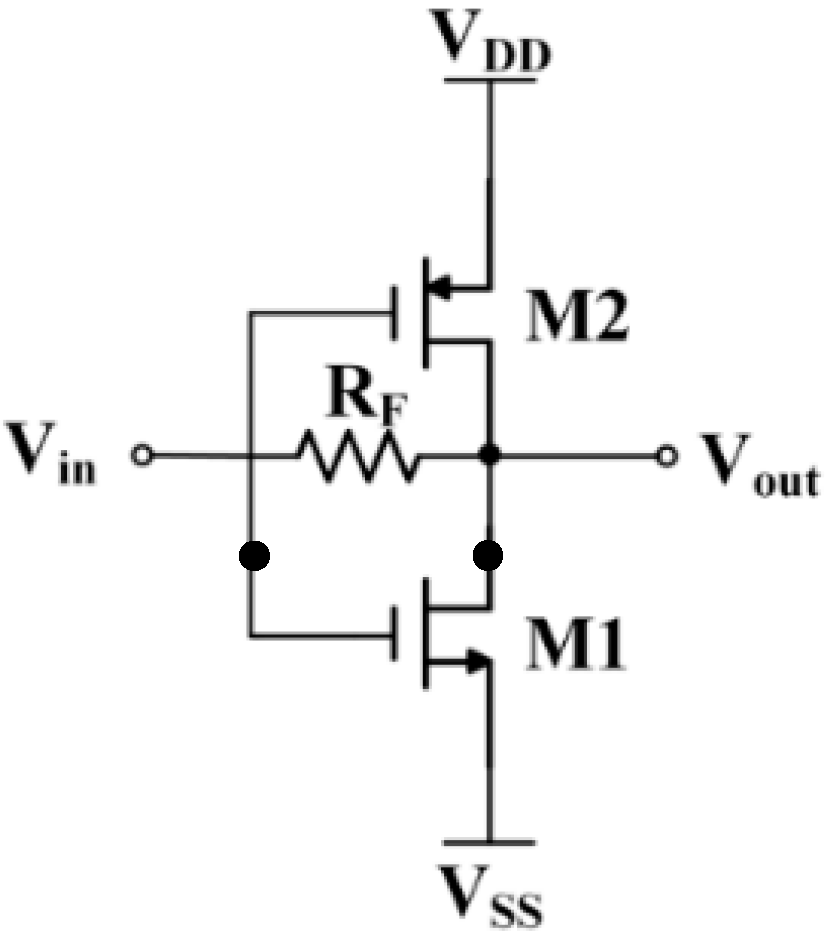
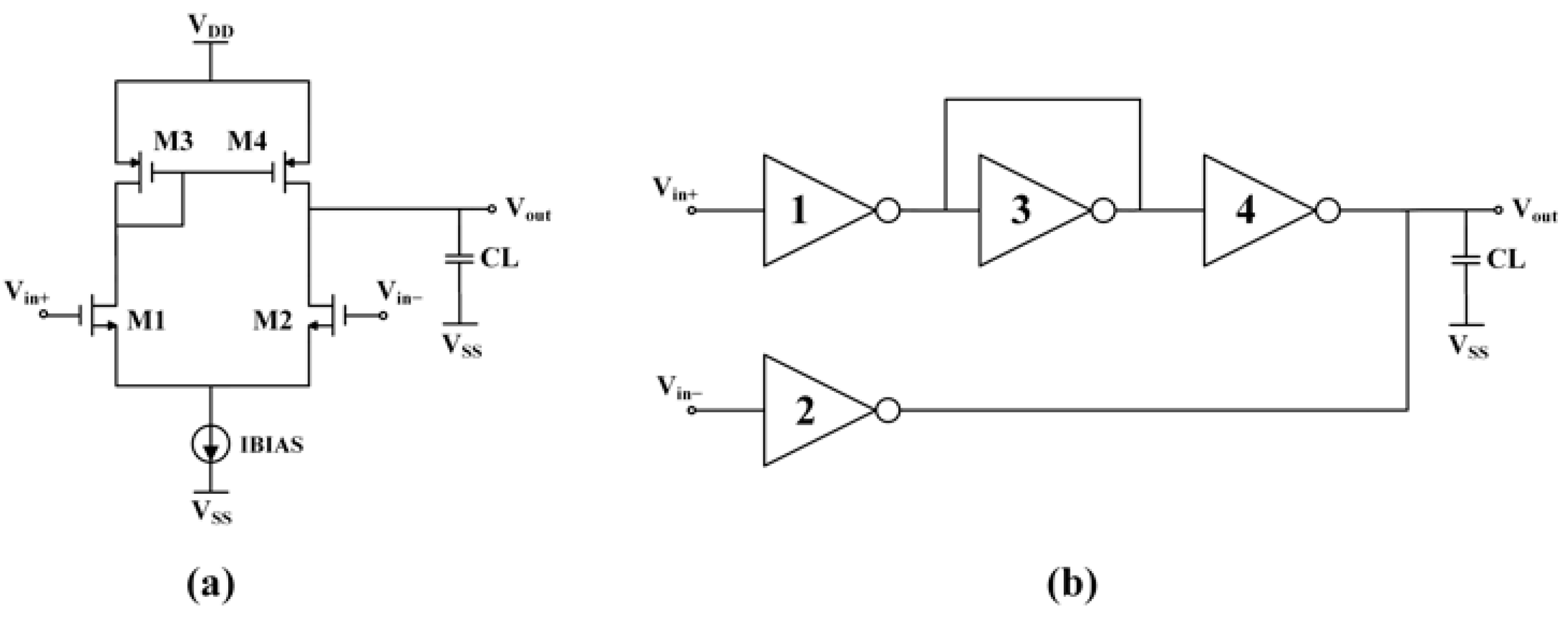

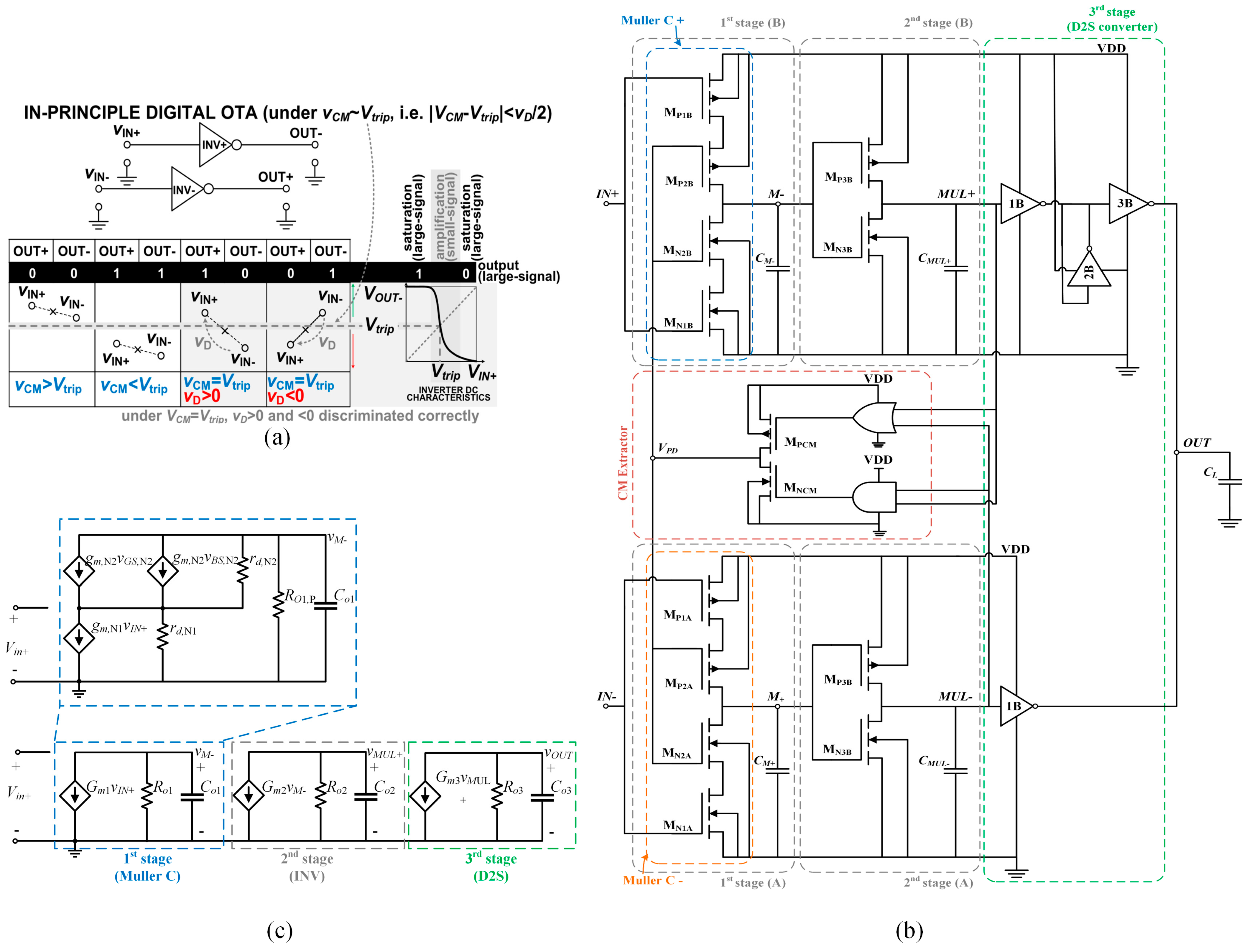
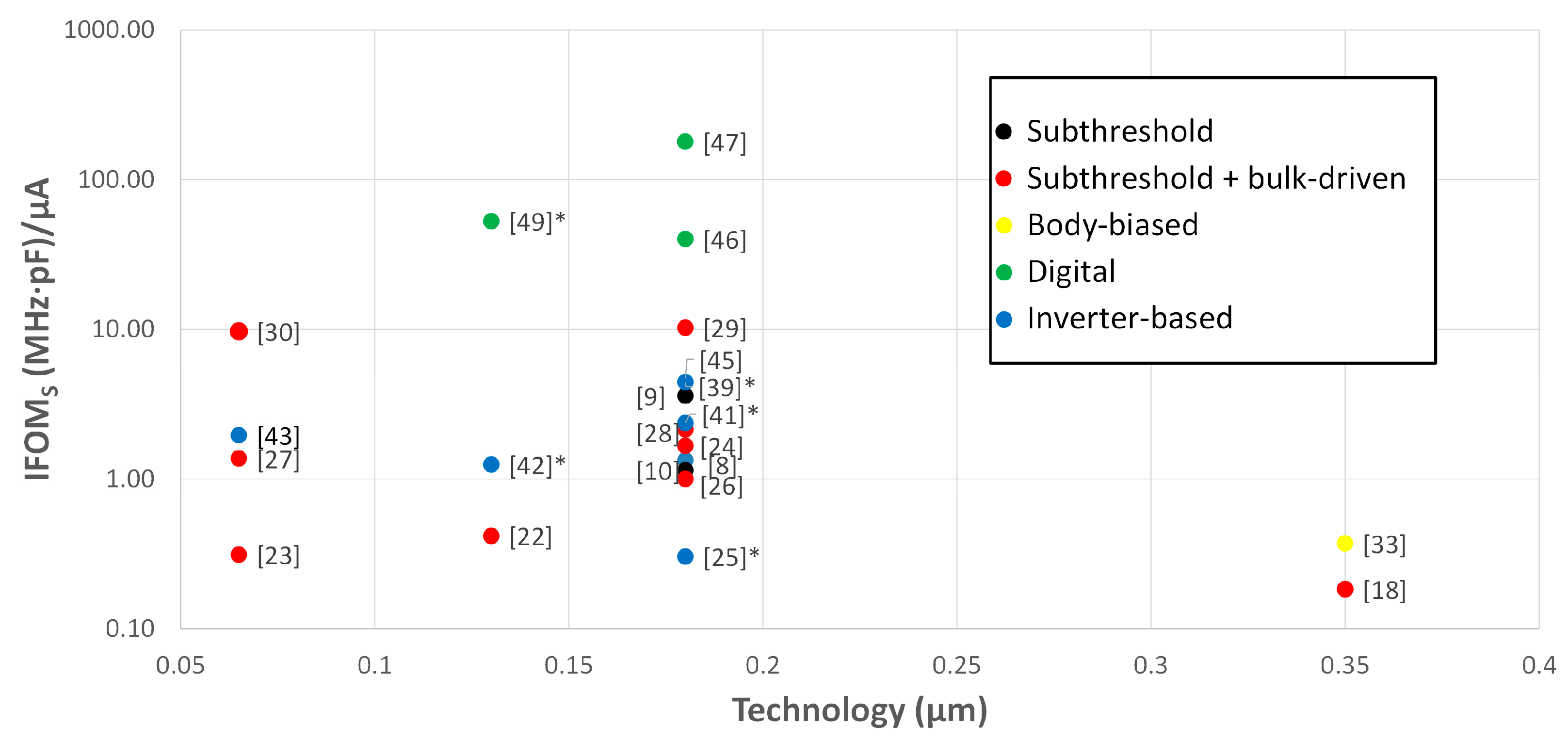
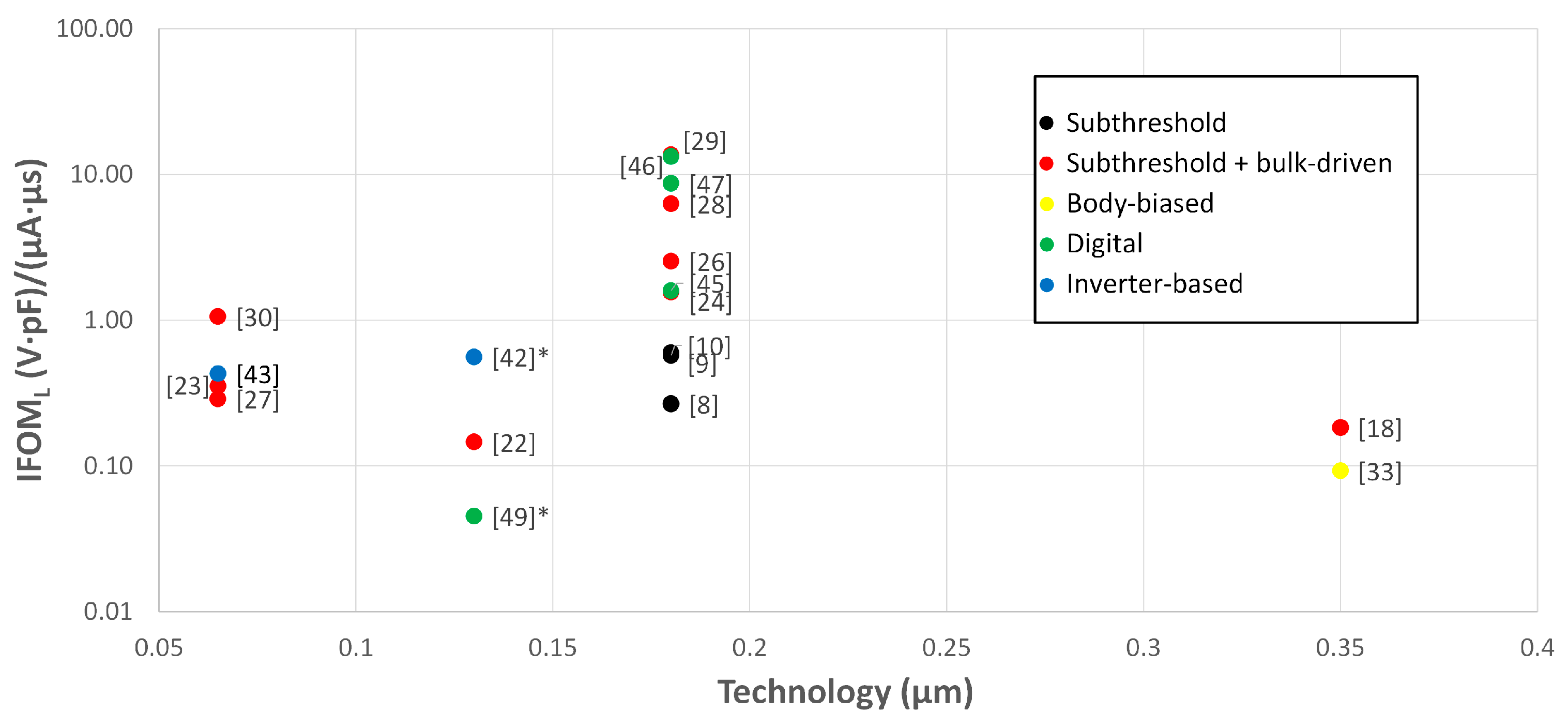
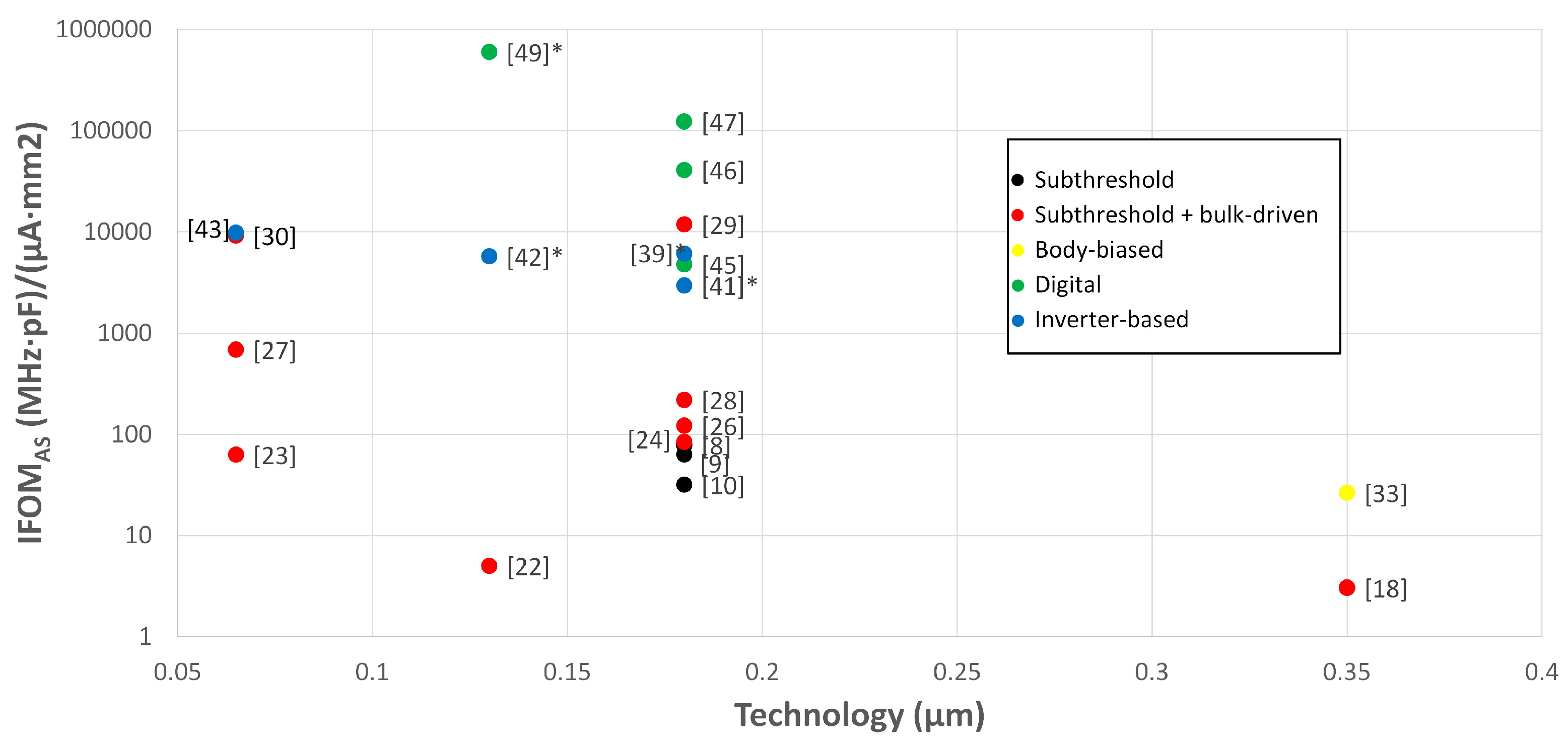
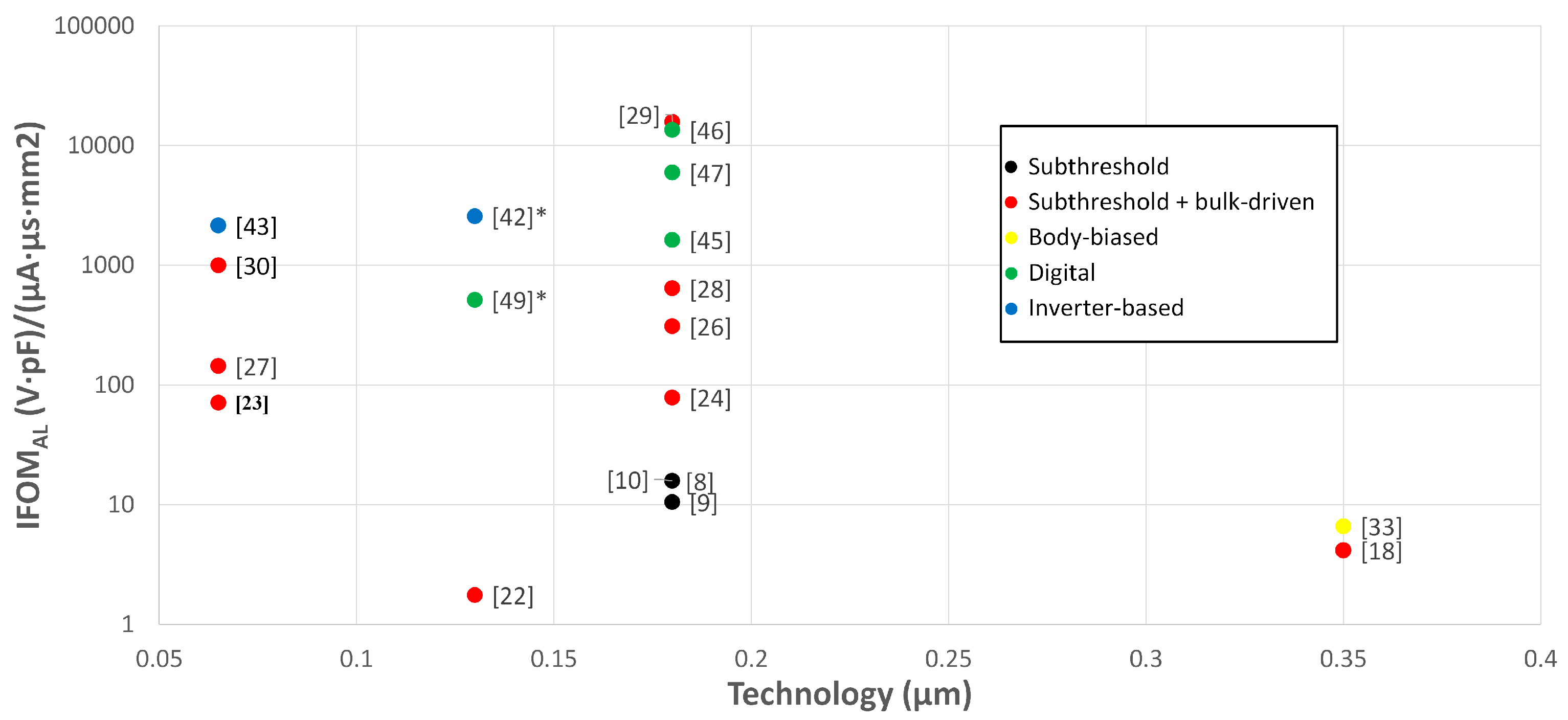
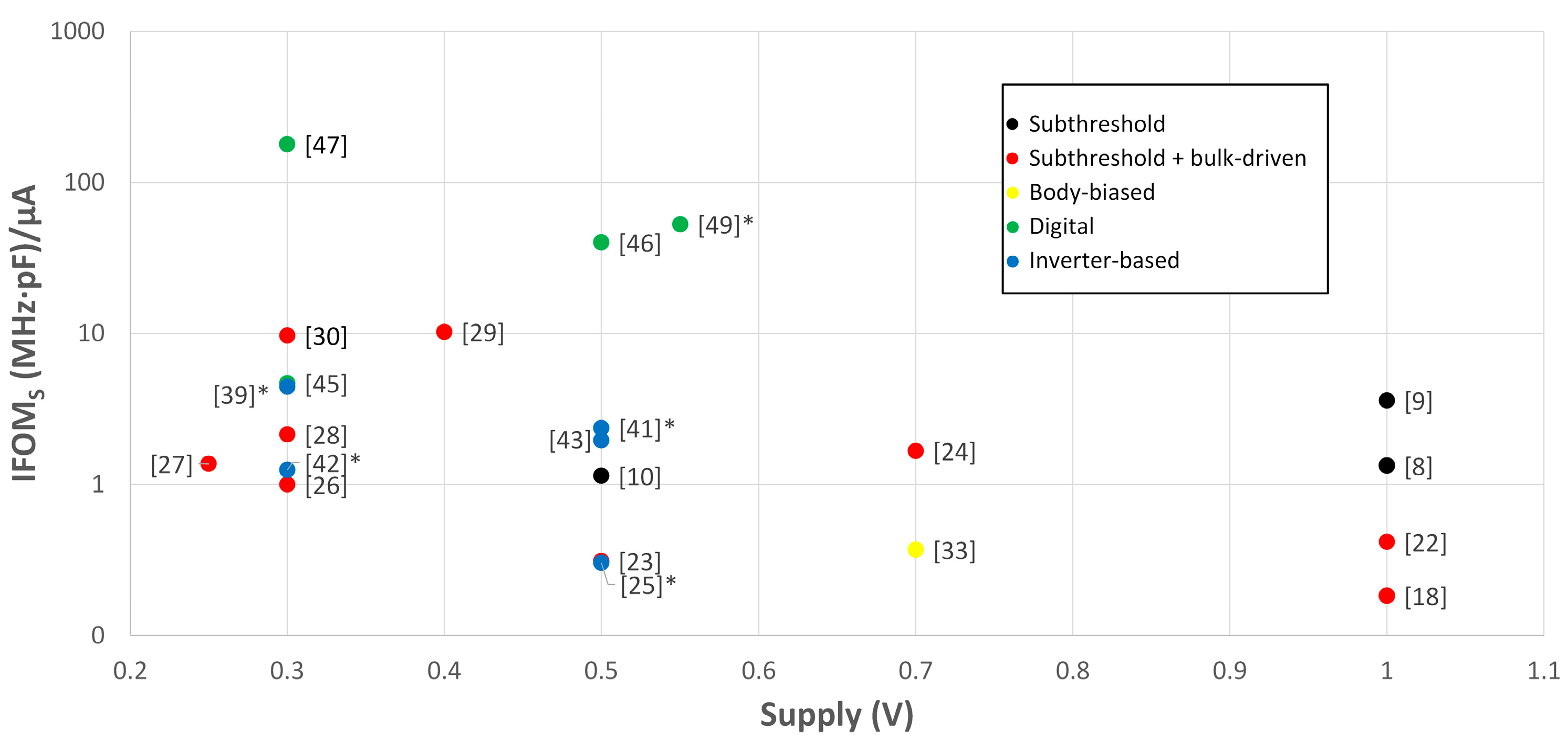

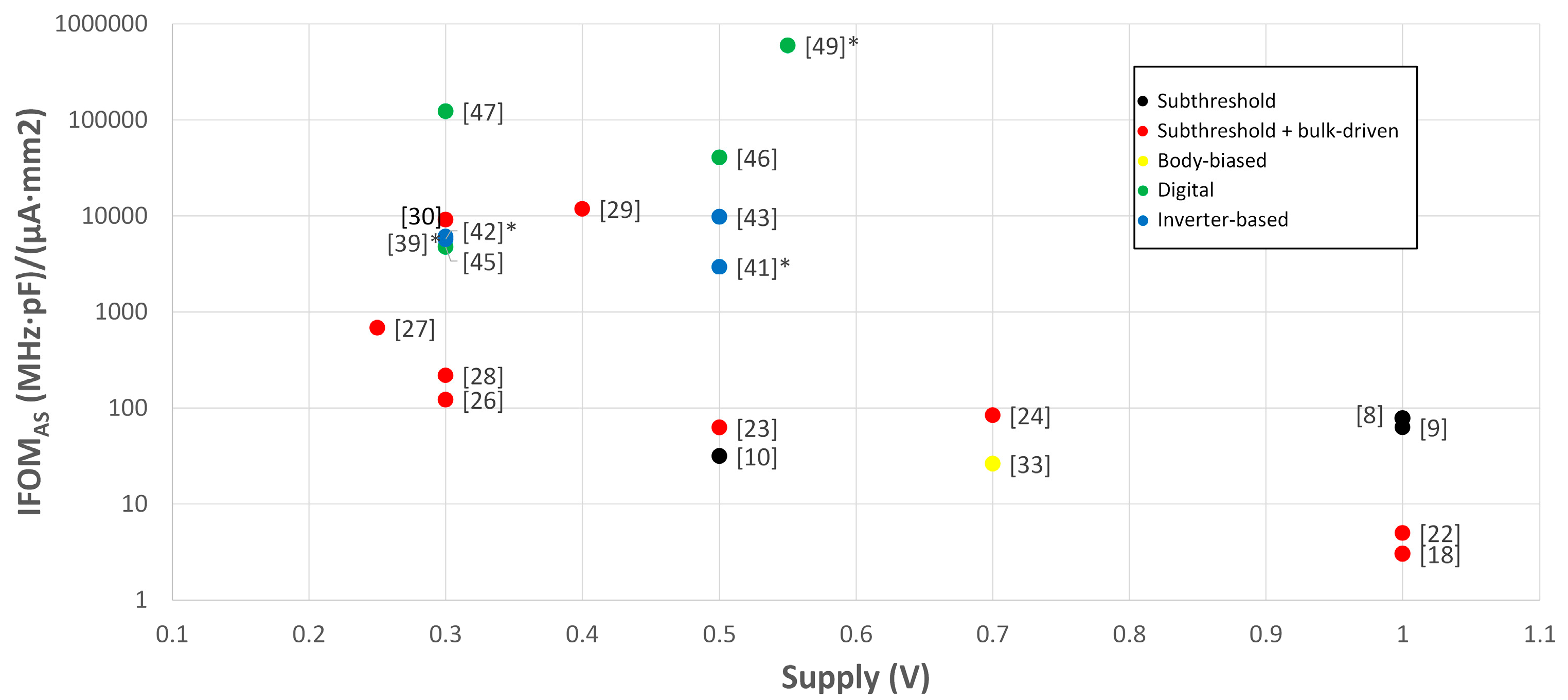
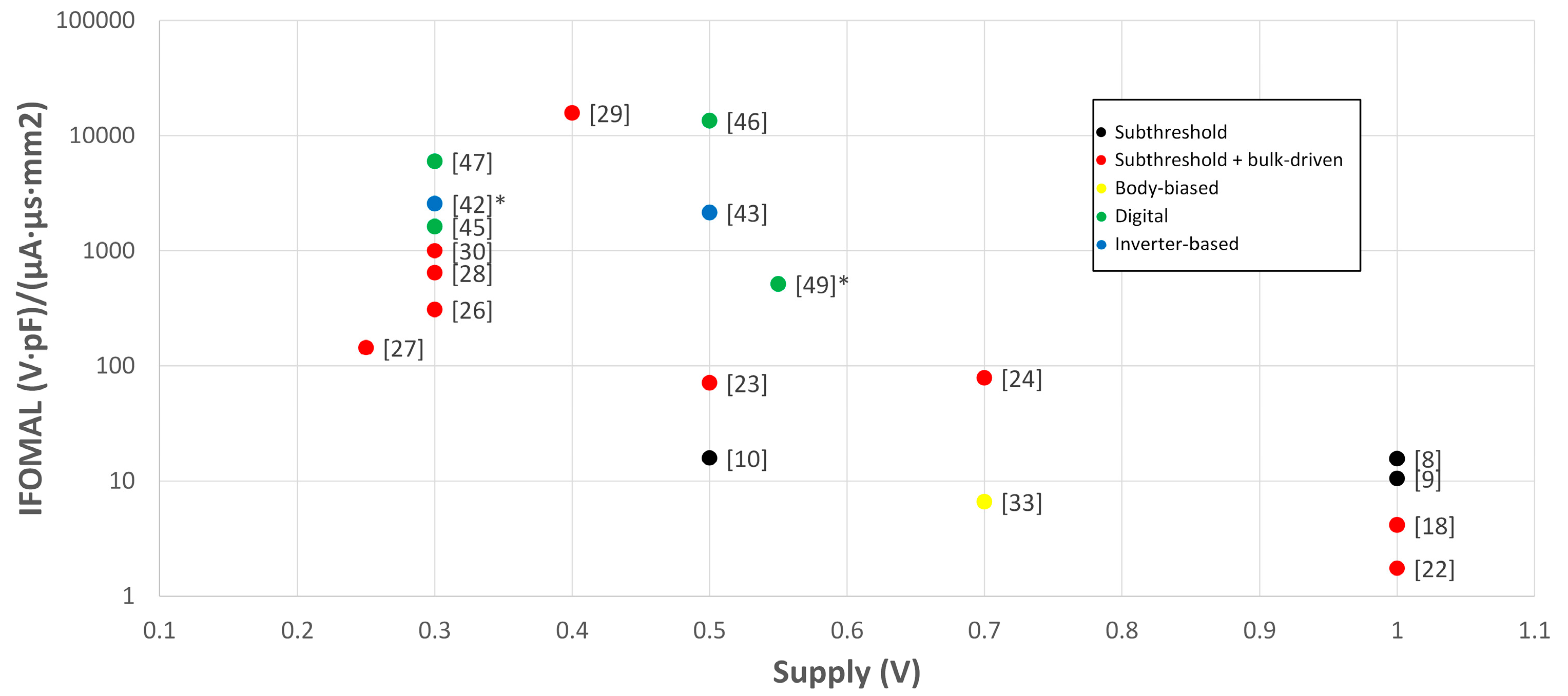
| Subthreshold | Above Threshold Bulk-Driven | |||
|---|---|---|---|---|
| (1a) | (1b) | |||
| (2a) | (2b) | |||
| (3a) | (3b) | |||
| (4a) | (4b) | |||
| [8] | [9] | [10] | [18] | [22] | [23] | [24] | [26] | [28] | [27] | [29] | [30] | [33] | [25] * | [41] * | [39] * | [43] | [42] * | [45] | [47] | [46] | [49] | |
|---|---|---|---|---|---|---|---|---|---|---|---|---|---|---|---|---|---|---|---|---|---|---|
| Year | 2005 | 2014 | 2016 | 2007 | 2014 | 2015 | 2016 | 2018 | 2020 | 2020 | 2022 | 2023 | 2017 | 2017 | 2020 | 2020 | 2022 | 2022 | 2020 | 2021 | 2021 | 2021 |
| Tech. [μm] | 0.18 | 0.18 | 0.18 | 0.35 | 0.13 | 0.065 | 0.18 | 0.18 | 0.18 | 0.065 | 0.18 | 0.065 | 0.35 | 0.18 | 0.18 | 0.18 | 0.065 | 0.13 | 0.18 | 0.18 | 0.18 | 0.13 |
| Op. modeb | SUB | SUB | SUB | SUB, BD | SUB, BD | SUB, BD | BD | SUB, BD | SUB, BD | SUB, BD | SUB, BD | BD | BB | INV | INV | INV | INV | INV | DIG | DIG | DIG | DIG |
| Area [mm2] × 10−2 | 1.7 | 5.7 | 3.6 | 6 | 8.3 | 0.5 | 2 | 0.8 | 1 | 0.2 | 0.9 | 0.11 | 1.4 | - | 0.08 | 0.07 | 0.02 | 0.02 | 0.1 | 0.1 | 0.1 | 0.01 |
| Supply [V] | 0.5 | 0.5 | 0.5 | 0.6 | 0.25 | 0.5 | 0.7 | 0.3 | 0.3 | 0.25 | 0.4 | 0.3 | 0.7 | 0.5 | 0.5 | 0.3 | 0.5 | 0.3 | 0.3 | 0.3 | 0.5 | 0.55 |
| CL [pF] | 20 | 30 | 40 | 15 | 15 | 3 | 20 | 20 | 30 | 15 | 150 | 50 | 10 | 20 | 10 | 10 | 0.5 | 2 | 150 | 80 | 150 | 250 |
| DC gain [dB] | 62 | 70 | 77 | 69 | 60 | 46 | 57 | 63 | 98.1 | 70 | 37 | 38 | 65 | 91 | 25.2 | 51 | 64 | 34.97 | 30 | 30 | 73 | 87 |
| IT [μA] | 150 | 0.15 | 0.14 | 0.9 | 0.072 | 366 | 36 | 0.056 | 0.043 | 0.104 | 0.081 | 8.5 | 27 | 26 | 0.558 | 0.002 | 1.75 | 20.3 | 0.008 | 0.002 | 0.215 | 14.9 |
| Power [μW] | 75 | 0.075 | 0.07 | 0.54 | 0.018 | 183 | 25.2 | 0.017 | 0.013 | 0.026 | 0.033 | 2.55 | 18.9 | 13 | 0.279 | 0.001 | 0.875 | 6.1 | 0.002 | 0.001 | 0.108 | 8.2 |
| GBW [kHz] | 0.01 | 18 | 4 | 11 | 2 | 38,000 | 3000 | 3 | 3 | 10 | 6 | 1650 | 1000 | 394 | 132 | 0.74 | 6850 | 12,700 | 0.2 | 4 | 60 | 3150 |
| PM [°] | 60 | 55 | 56 | 65 | 53 | 57 | 60 | 61 | 54 | 88 | 79 | 70.3 | 60 | 59 | 87 | 90 | 62 | 62 | - | 54 | - | 65 |
| SR [V/ms) | 2000 | 3 | 2 | 15 | 0.7 | 43,000 | 2800 | 7 | 9 | 2 | 7.9 | 180 | 250 | - | - | - | 1510 | 5680 | 0.1 | 0.2 | 19 | 2.7 |
| Noise [nV/sqrt(Hz)] | 280 | 310 | - | 290 | 3300 | 926 | 100 | 1850 * | 1800 * | - | - | 250 | 65 | 31.8 | - | 809 | - | - | 21,000 | - | - | 175 |
| CMRR (dB) | 65 | - | 55 | 74.5 | - | 35 | 19 | 72 | 60 | 62.5 | 36 | 39.8 | 45 | - | - | 37 | - | 27 | 41 | - | 65 | 46 |
| PSRR [dB] | 43 | - | 52 | - | - | 37 | 52 | 62 | 61 | 38 | 30 | 44.7 | 50 | 122.3 | 76.8 | 41 | - | - | 30 | - | 50 | 39 |
| # stages | 2 | 2 | 2 | 2 | 2 | 3 | 3 | 2 | 3 | 3 | 1 | 3 | 2 | - | - | - | 4 | - | - | - | - | - |
| FOMS [MHz·pF/μW] | 2.67 | 7.20 | 2.29 | 0.31 | 1.67 | 0.62 | 2.38 | 3.33 | 7.15 | 5.48 | 25.6 | 32.35 | 0.53 | 0.61 | 4.73 | 14.8 | 3.91 | 4.16 | 15.6 | 598 | 80.2 | 96.0 |
| FOML [(V/μs)·pF/μW] | 0.53 | 1.20 | 1.14 | 0.42 | 0.58 | 0.7 | 2.22 | 8.45 | 21 | 1.15 | 34.1 | 3.53 | 0.13 | - | - | - | 0.86 | 1.86 | 5.31 | 28.96 | 26.5 | 0.08 |
| IFOMS [MHz·pF/μA] | 1.33 | 3.60 | 1.14 | 0.18 | 0.42 | 0.31 | 1.67 | 1 | 2.15 | 1.37 | 10.3 | 9.71 | 0.37 | 0.30 | 2.37 | 4.44 | 1.96 | 1.25 | 4.69 | 179 | 40.1 | 52.8 |
| IFOML [(V/μs)·pF/μA] | 0.27 | 0.60 | 0.57 | 0.25 | 0.15 | 0.35 | 1.56 | 2.54 | 6.3 | 0.29 | 13.64 | 1.06 | 0.09 | - | - | - | 0.43 | 0.56 | 1.59 | 8.69 | 13.3 | 0.05 |
| IFOMAS [MHz·pF/μA·mm2] | 78.43 | 63.16 | 31.75 | 3 | 5 | 63 | 84 | 122 | 219 | 685 | 11,838 | 9156 | 26.5 | - | 2957 | 6107 | 9786 | 5730 | 4773 | 122,627 | 40,852 | 598,189 |
| IFOMAL [[(V/μs)·pF/μA·mm2] | 15.69 | 10.53 | 15.87 | 4.2 | 1.8 | 71.2 | 78.6 | 309.2 | 642.9 | 144.2 | 15,745 | 999 | 6.6 | - | - | - | 2150 | 2565 | 1623 | 5943 | 13,499 | 513 |
Disclaimer/Publisher’s Note: The statements, opinions and data contained in all publications are solely those of the individual author(s) and contributor(s) and not of MDPI and/or the editor(s). MDPI and/or the editor(s) disclaim responsibility for any injury to people or property resulting from any ideas, methods, instructions or products referred to in the content. |
© 2023 by the authors. Licensee MDPI, Basel, Switzerland. This article is an open access article distributed under the terms and conditions of the Creative Commons Attribution (CC BY) license (https://creativecommons.org/licenses/by/4.0/).
Share and Cite
Grasso, A.D.; Pennisi, S.; Venezia, C. A Survey of Ultra-Low-Power Amplifiers for Internet of Things Nodes. Electronics 2023, 12, 4361. https://doi.org/10.3390/electronics12204361
Grasso AD, Pennisi S, Venezia C. A Survey of Ultra-Low-Power Amplifiers for Internet of Things Nodes. Electronics. 2023; 12(20):4361. https://doi.org/10.3390/electronics12204361
Chicago/Turabian StyleGrasso, Alfio Dario, Salvatore Pennisi, and Chiara Venezia. 2023. "A Survey of Ultra-Low-Power Amplifiers for Internet of Things Nodes" Electronics 12, no. 20: 4361. https://doi.org/10.3390/electronics12204361
APA StyleGrasso, A. D., Pennisi, S., & Venezia, C. (2023). A Survey of Ultra-Low-Power Amplifiers for Internet of Things Nodes. Electronics, 12(20), 4361. https://doi.org/10.3390/electronics12204361







